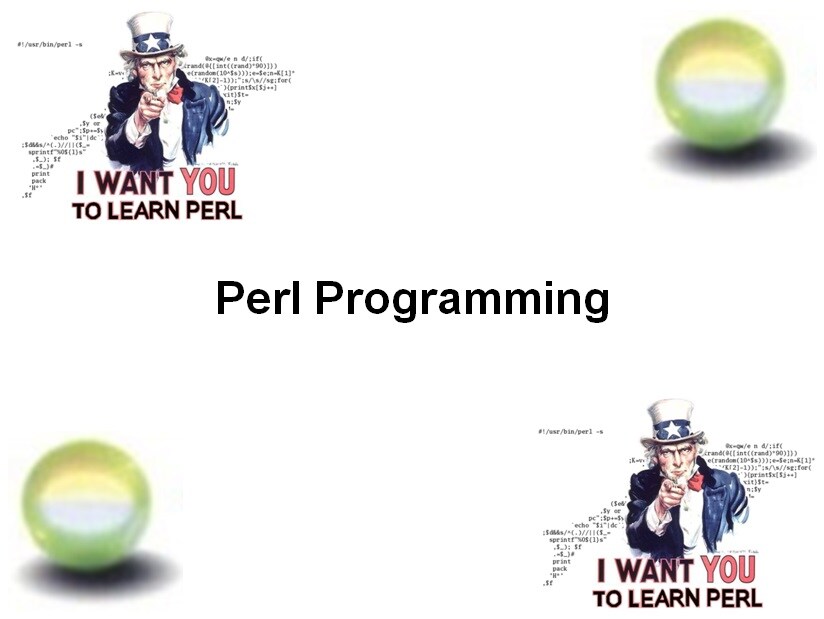-
Learning by doing
-
Trainers with practical experience
-
Classroom training
-
Detailed course material
-
Clear content description
-
Tailormade content possible
-
Training that proceeds
-
Small groups
In the course Perl Programming the principles of the Perl programming language are discussed.
After an introduction on the characteristics of Perl, Perl modules and the typical usages of Perl, it is shown how a typical Perl script is executed.
Subsequently, attention is paid to the syntax and use of scalar types, variables, operators and control structures. The use of Perl data structures like arrays, lists and hashes is also discussed.
Part of the course is also the interaction between scripts and input and output devices such as keyboard and console and also attention is paid to the dealing with files and directories. In this respect the diamond and chomp operator are discussed.
Using subroutines in Perl is part of the subject matter as well. On the basis of a number of structured exercises, participants learn how regular expressions in Perl can be used to validate data and to search for specific string patterns.
Finally, an introduction to object oriented programming in Perl is given and it is discussed how additional Perl modules can be installed and used. Several Perl modules can be used as examples such as modules for Graphical User Interfaces or database access.
Interspersed in other subjects the debugging of Perl scripts with the Perl debugger is also treated.
The course Perl Programming is intended for System administrators, Web masters and developers who want to learn to program in Perl or who want to understand Perl code.
Knowledge and experience with programming is not strictly required to participate in this course but is beneficial to a proper understanding.
The theory is treated on the basis of presentation slides and is interspersed with exercises. Illustrative demo programs further clarify the concepts covered. The course contents covers the topics of the CIW Perl exam (1D0-437). The course material is in English.
Participants receive an official Perl Programming certificate after successful completion of the course.

Module 1 : Perl Introduction |
Module 2 : Scalar Types and Variables |
Module 3 : Control Flow |
| What is Perl? Perl Characteristics Hello World in Perl Typical Perl Script strict Pragma Perl Modules Installation Perl IDE's Interactive Perl Resources for Perl Usages of Perl Perl Script reading Input Perl CGI Script |
Scalar Variables Numbers and Numeric Operators Strings and String Literals String Number Conversions Scalar Variable Interpolation Reading from STDIN Comparison Operators if and while control structures Boolean Values chomp Operator undef Value and defined Function Special Scalar Variables References and dereferencing |
Conditional Statements if elsif and else unless and unless else Logical AND and OR Conditional Expression Operator given when Loop Statements while and do..while until and do..until for and foreach Jump Statements next and last redo and goto |
Module 4 : Lists and Arrays |
Module 5 : Subroutines |
Module 6 : Input and Output |
| What are Arrays and Lists? Accessing Array Elements Array Operations Special Array Indices qw Shortcut List Assignment pop, push, shift and unshift sort and reverse Interpolating Arrays into Strings foreach Control Structure Default Variable $_ Scalar and List Context Multidimensional Arrays |
Subroutines Defining a Subroutine Invoking a Subroutine Return Values Arguments Private Variables my Variables Variable-Length Parameter Lists return Operator Non Scalar Return Values State Variables More on Parameter Passing Another Subroutine Example |
Reading from STDIN Input from Diamond Operator Invocation Arguments Formatted Output Arrays and printf File Handles Reading from a File Changing Default File Handle Reading Whole File File Tests Operators Manipulate Files/Directories Listing Directories Executing External Programs |
Module 7 : Hashes |
Module 8 : Regular Expressions |
Module 9 : Perl Modules |
|
Benefits of Hashes Hash Element Access Hash as a Whole Hash Assignment More Hash Syntax Hash Element Interpolation Hash Functions More Hash Functions The %ENV Hash Counting with Hash Merging Hashes |
Simple Patterns Meta Characters Quantifiers and Character Classes Regular Expression Delimiters Subgrouping and Backreferences Regular Expression Modifiers split and join Named Captures Named Backreferences Automatic Match Variables Substitutions with s/// |
What are Perl Modules? Packages my versus our Variables Module Naming Module Namespace Creating and Using Modules Modules in Subdirectories Accessing Module Variables Exporting from Modules Importing Modules Recommended CPAN Modules |
Module 10 : Object Orientation |
||
| Object Oriented Programming Object Oriented Programming in Perl Classes and Objects Example Class and Objects Class Constructor Properties or Fields Methods and Accessors Using Objects Inheritance Inheritance with @ISA Array Overridden Methods |
